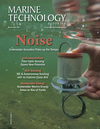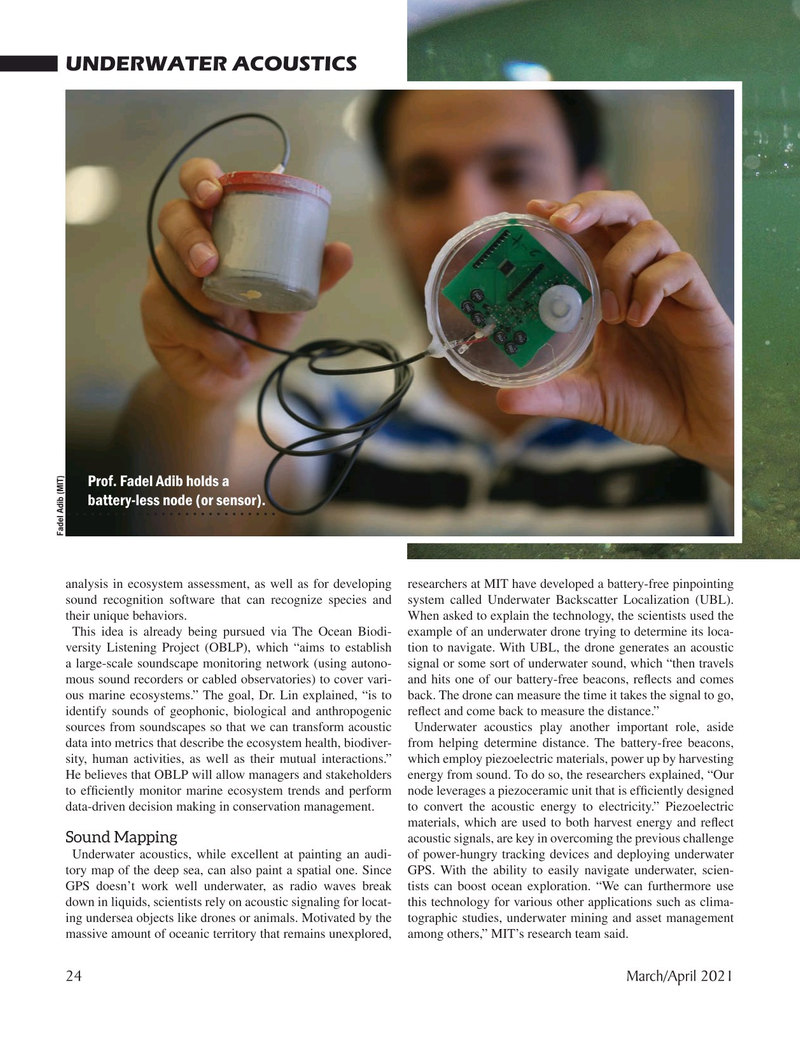
Page 24: of Marine Technology Magazine (March 2021)
Oceanographic Instrumentation & Sensors
Read this page in Pdf, Flash or Html5 edition of March 2021 Marine Technology Magazine
UNDERWATER ACOUSTICS
Prof. Fadel Adib holds a battery-less node (or sensor).
Fadel Adib (MIT) analysis in ecosystem assessment, as well as for developing researchers at MIT have developed a battery-free pinpointing sound recognition software that can recognize species and system called Underwater Backscatter Localization (UBL). their unique behaviors. When asked to explain the technology, the scientists used the
This idea is already being pursued via The Ocean Biodi- example of an underwater drone trying to determine its loca- versity Listening Project (OBLP), which “aims to establish tion to navigate. With UBL, the drone generates an acoustic a large-scale soundscape monitoring network (using autono- signal or some sort of underwater sound, which “then travels mous sound recorders or cabled observatories) to cover vari- and hits one of our battery-free beacons, re? ects and comes ous marine ecosystems.” The goal, Dr. Lin explained, “is to back. The drone can measure the time it takes the signal to go, identify sounds of geophonic, biological and anthropogenic re? ect and come back to measure the distance.” sources from soundscapes so that we can transform acoustic Underwater acoustics play another important role, aside data into metrics that describe the ecosystem health, biodiver- from helping determine distance. The battery-free beacons, sity, human activities, as well as their mutual interactions.” which employ piezoelectric materials, power up by harvesting
He believes that OBLP will allow managers and stakeholders energy from sound. To do so, the researchers explained, “Our to ef? ciently monitor marine ecosystem trends and perform node leverages a piezoceramic unit that is ef? ciently designed data-driven decision making in conservation management. to convert the acoustic energy to electricity.” Piezoelectric materials, which are used to both harvest energy and re? ect
Sound Mapping acoustic signals, are key in overcoming the previous challenge
Underwater acoustics, while excellent at painting an audi- of power-hungry tracking devices and deploying underwater tory map of the deep sea, can also paint a spatial one. Since GPS. With the ability to easily navigate underwater, scien-
GPS doesn’t work well underwater, as radio waves break tists can boost ocean exploration. “We can furthermore use down in liquids, scientists rely on acoustic signaling for locat- this technology for various other applications such as clima- ing undersea objects like drones or animals. Motivated by the tographic studies, underwater mining and asset management massive amount of oceanic territory that remains unexplored, among others,” MIT’s research team said.
24 March/April 2021
MTR #3 (18-33).indd 24 3/22/2021 6:54:39 PM

 23
23

 25
25
